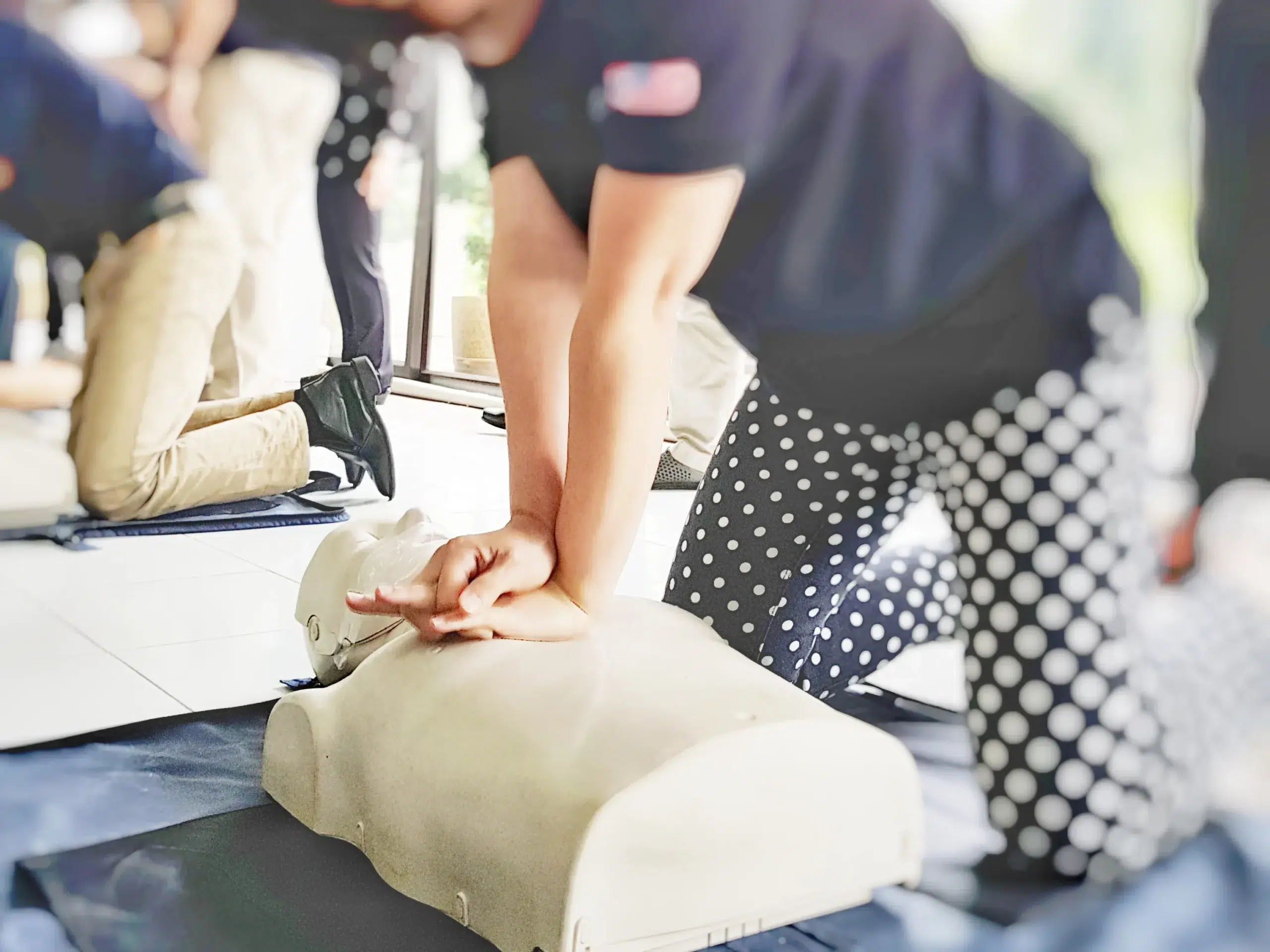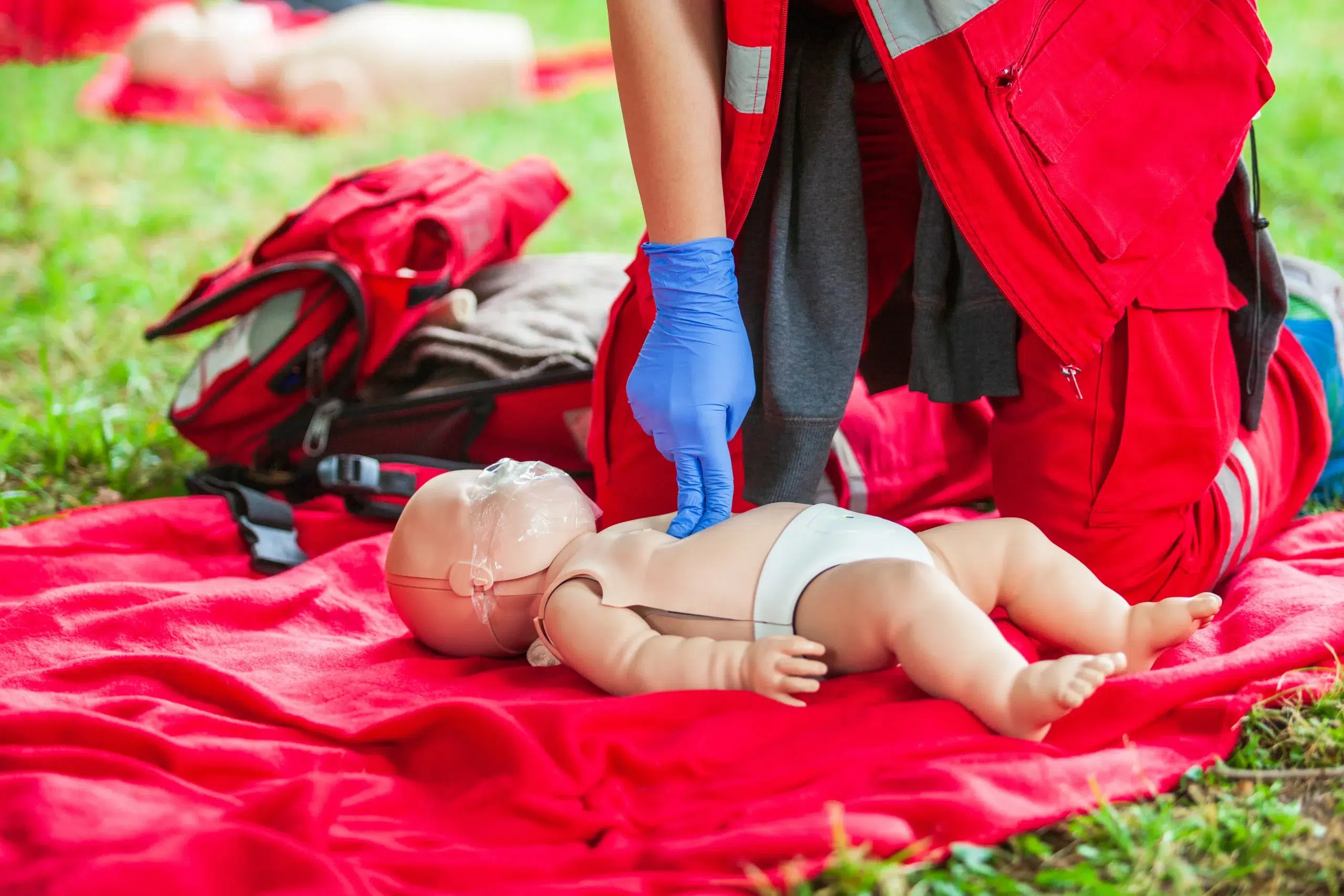Empowering yourself with lifesaving skills has never been easier, thanks to the accessibility of online CPR classes. If you’re in the San Ramon area and searching for “online CPR classes in San Ramon,” this guide will help you find the perfect fit. We’ll explore the advantages of online learning, address common misconceptions about CPR, and highlight top-rated providers in San Ramon, Dublin, and Danville, including Danville CPR Classes, a woman-owned business known for its commitment to affordable, high-quality training. We’ll also break down the different types of CPR certifications available, from basic CPR and First Aid to advanced certifications like ACLS and PALS, and guide you through the process of choosing the right course, preparing for your online modules, and scheduling your in-person skills check.
Key Takeaways
- Online CPR training blends convenience with crucial hands-on skills practice. Find a program that fits your schedule and offers in-person skills sessions, like those at Danville CPR Classes.
- Different CPR certifications, like BLS, ACLS, and PALS, cater to various needs. Choose the certification that aligns with your goals, whether you’re a healthcare professional, childcare provider, or simply want to be prepared for emergencies.
- A little preparation makes a big difference in your online CPR class experience. Check tech requirements, review any pre-course materials, and understand the skills check process for a smooth and successful learning journey.
What are Online CPR Classes?
Online CPR classes offer a convenient way to learn the lifesaving skills of cardiopulmonary resuscitation. They blend online learning with in-person skills sessions, giving you the flexibility to fit CPR training into your schedule. This hybrid approach allows you to study the cognitive components of CPR at your own pace, then demonstrate your skills in a hands-on session with a certified instructor. Danville CPR Classes offers a variety of online CPR courses that follow this blended learning model.
What are they?
Online CPR training typically involves interactive modules, videos, and simulations that guide you through the steps of CPR. You’ll learn how to recognize the signs of a cardiac arrest, how to perform chest compressions and rescue breaths, and how to use an automated external defibrillator (AED). The online portion allows you to review the material as often as needed until you feel comfortable with the concepts.
Benefits of online CPR training
The biggest advantage of online CPR classes is their flexibility. You can study whenever and wherever it’s convenient for you, eliminating the need to attend a traditional classroom course. This makes online learning a great option for busy professionals, parents, and anyone with a packed schedule. Plus, many reputable organizations offer affordable online CPR training, making it accessible to a wider audience. This accessibility is key to empowering more people with these vital skills.
Debunking online CPR myths
One common misconception about CPR is that it’s too complicated for the average person to learn. This simply isn’t true. Online CPR courses break down the steps of CPR into easy-to-understand segments, making it manageable for anyone to learn. Another myth is that only medical professionals can perform CPR. In reality, anyone can learn and perform CPR with proper training. Basic CPR knowledge can make a world of difference in an emergency situation, empowering individuals to act quickly and potentially save a life. Simple training can empower anyone to act.
Top Online CPR Class Providers in San Ramon
Finding the right CPR class can feel overwhelming, so we’ve compiled a list of trusted providers in San Ramon. This list includes options for blended learning (online coursework plus in-person skills sessions) and fully in-person classes to help you find the best fit.
Danville CPR Classes
Danville CPR Classes offers a flexible approach to CPR training by combining online learning with in-person skills sessions. This blended learning format lets you complete the coursework at your own pace, then demonstrate your skills with a certified instructor. They offer a range of American Heart Association courses, including BLS, ACLS, PALS, and CPR/First Aid. Danville CPR Classes also provides specialized training like the EMSA Child Care Health & Safety program and RQI classes for healthcare professionals. They serve San Ramon, Dublin, and Danville, and are proud to be a woman-owned business. Learn more about their commitment to affordable training through their low price guarantee.
Heart Start CPR
Heart Start CPR provides various training options, including online and onsite classes. They offer certification in CPR, First Aid, BLS, ACLS, and PALS. Their courses cater to both healthcare professionals and the general public. You can find more information on their website.
Safety Training Seminars
Safety Training Seminars offers American Heart Association-certified CPR, BLS, ACLS, and PALS classes in San Ramon. They hold classes daily and can also conduct on-site training for groups. This flexibility makes them a good option for businesses needing to train multiple employees. Learn more about their CPR class offerings in San Ramon.
CPR Training Center
The CPR Training Center is an American Heart Association-certified training center with nearly three decades of experience. They offer a range of courses, including CPR, ACLS, BLS, PALS, and NRP. Visit their website for more details on their training programs.
Online CPR Course Types & Key Features
Choosing the right CPR course depends on your specific needs and career path. This section breaks down the key features of different online CPR certifications, including BLS, ACLS, PALS, CPR/First Aid, and EMSA Child Care Health & Safety. Danville CPR Classes offers a variety of courses to meet your individual requirements.
Basic Life Support (BLS)
BLS certification provides the foundational knowledge and skills to respond to life-threatening emergencies. You’ll learn how to perform CPR, use an AED, and relieve choking. BLS certification is essential for healthcare providers and anyone who wants to be prepared to help in a crisis. It covers single-rescuer and team-based resuscitation techniques, emphasizing high-quality CPR and the importance of the chain of survival.
Advanced Cardiac Life Support (ACLS)
ACLS certification goes beyond the basics of CPR. Designed for healthcare professionals, ACLS teaches advanced techniques for managing cardiovascular emergencies, including cardiac arrest, stroke, and acute coronary syndromes. The course covers topics like airway management, pharmacology, and ECG interpretation, enabling healthcare providers to make quick, informed decisions in critical situations.
Pediatric Advanced Life Support (PALS)
PALS certification focuses on the specialized skills needed to respond to emergencies involving infants and children. This course equips healthcare providers with the knowledge and techniques to assess, manage, and stabilize pediatric patients in respiratory distress, shock, or cardiac arrest. PALS emphasizes the importance of early recognition and intervention to improve outcomes for young patients.
CPR & First Aid
Combined CPR and First Aid training prepares you to handle a wider range of emergencies, from cardiac arrest to common injuries like cuts, burns, and fractures. This comprehensive training is valuable for anyone, especially those working in childcare, education, or other community settings. You’ll learn how to assess injuries, control bleeding, and provide basic wound care.
EMSA Child Care Health & Safety
The EMSA Child Care Health & Safety program offers specialized training for childcare providers in California. This program covers essential topics like preventing sudden infant death syndrome (SIDS), recognizing and responding to childhood illnesses, and maintaining a safe environment for children. It meets the specific requirements for childcare licensing in California and provides practical skills for handling health and safety emergencies in a childcare setting.
Get Certified in CPR Online
Getting your CPR certification online blends convenience with practical skills. Here’s how it works:
Online Components
The online portion of your CPR training uses the RQI software. This allows you to learn at your own pace and review material as needed. Watching the online review videos before your skills check significantly increases your chances of passing.
In-person Skills Check
After completing the online modules, you’ll schedule an in-person skills check. This hands-on session uses a voice-activated mannequin to evaluate your technique. While an instructor isn’t always present, support is available by phone if you have any questions. This blended approach allows for scheduling flexibility while ensuring you receive the guidance you need.
Time Commitment per Course
The online coursework length depends on the course and your prior experience. Basic Life Support (BLS) typically takes 1–2 hours, while Advanced Cardiac Life Support (ACLS) or Pediatric Advanced Life Support (PALS) requires 3–4 hours. You can explore our CPR and First Aid certification courses for more details.
Certification & Renewal
Once you successfully complete the in-person skills check, you’ll receive your certification card that same day. These certifications are valid for two years. Our RQI classes offer seamless renewal options when the time comes. We also offer a low price guarantee, ensuring you’re getting the best value. Contact us with any questions.
Online CPR Class Pricing & Discounts in San Ramon
Compare Provider Prices
Shopping around for the best price on CPR certification is smart, especially in a place like San Ramon where several providers offer similar courses. You’ll find that online CPR training typically costs less than in-person classes. Expect online options to range from around $20 to $100, while classroom-based courses can run anywhere from $40 to upwards of $200. Factors like the specific type of certification (Basic Life Support, First Aid, etc.) and the training center will influence the final price. A good starting point for comparing typical CPR costs is this helpful guide. Remember, prices can change, so it’s always best to check directly with the provider for their most up-to-date pricing. For more on CPR training expenses, check out this resource.
Group Discounts & Offers
If you’re coordinating CPR training for a group, whether it’s for your company, a community organization, or even a group of friends, be sure to ask about group discounts. Many providers, including Danville CPR Classes, offer reduced rates for group bookings. This can be a great way to make training more affordable and convenient, especially if you can arrange for an on-site class. Some providers also extend discounts to students, so if you’re currently enrolled in school, inquire about potential savings.
Low Price Guarantees
Look for training centers that offer a low price guarantee. This demonstrates their commitment to providing accessible training and confidence in their pricing. A low-price guarantee means that if you find a comparable course at a lower price elsewhere, the provider will match or even beat that price. This takes the guesswork out of finding the best deal and ensures you’re getting quality training at a fair price. Danville CPR Classes is one example of a provider committed to offering competitive rates.
Instructor Qualifications & Training Center Reputation
When choosing an online CPR class, the instructor’s qualifications and the training center’s reputation are essential factors. You want to learn from seasoned professionals and trust that the training meets industry standards.
Instructor Experience
Look for training centers with instructors who have real-world experience. Professionals like paramedics, EMTs, and registered nurses bring practical knowledge that enriches the learning process. For example, Heart Start CPR emphasizes the real-world experience of its instructors, highlighting the value of learning from those who’ve used these skills in emergencies. This practical insight can significantly impact the quality of your training.
Training Center Accreditation
Accreditation shows a training center’s commitment to high standards. Check if the center is accredited by a recognized organization like the American Heart Association (AHA). CPR Training San Ramon, for instance, has been an AHA-certified training center for 28 years, demonstrating a long-term dedication to maintaining current training materials and techniques. A training center’s accreditation history provides valuable insight into its commitment to quality.
AHA Affiliation
Affiliation with the American Heart Association (AHA) is a strong indicator of a CPR training program’s quality. The AHA sets the standard for CPR and emergency cardiovascular care. Choosing an AHA-affiliated program ensures you’re learning the most current, effective techniques. Heart Start CPR has been AHA-certified since 2003, demonstrating its commitment to national standards. Safety Training Seminars also offers AHA-certified courses in San Ramon, providing students with multiple options for high-quality, accredited training in the area. An AHA-affiliated program ensures your certification is widely recognized.
Choose the Right Online CPR Class
Finding the right online CPR class takes a little research, but it’s worth it to ensure you get the training you need. Here’s a straightforward approach:
Define your needs & goals
Before you even start looking at courses, think about why you want to learn CPR. Are you a healthcare provider who needs to maintain certification? A parent wanting to be prepared for emergencies at home? Or is it for a job requirement? Understanding your goals will help you choose the right course level. Figuring out your “why” is the first step. Healthcare professionals often need courses like ACLS and PALS, while a CPR and First Aid course might be perfect for others.
Evaluate course features
Online CPR classes aren’t all the same. Some offer extra resources like downloadable guides or videos, while others primarily stick to online modules. Look at what each course includes and see what works for your learning style. Do you like interactive exercises or straightforward instruction? Consider features like practice tests and refresher materials, too.
Consider schedule flexibility
One of the best things about online CPR training is the flexibility. You can usually work through the online modules at your own pace, fitting them around your schedule. However, remember that most online CPR certifications require an in-person skills check. Make sure the course offers skills sessions that work for you. Online CPR training offers a convenient way to learn this important skill.
Check for skills assessment options
The hands-on part of CPR training is crucial. Check how each provider handles the skills assessment. Do they have various locations or times available? What kind of feedback will you get? Some providers use voice-activated mannequins and offer phone support, while others require an in-person instructor. Understanding the skills check process will help you feel prepared and confident. Contact us to learn more about our skills check process at Danville CPR Classes.
Prepare for Your Online CPR Class
Getting ready for your online CPR class is straightforward. A little prep work goes a long way toward a smooth and successful learning experience. Here’s what you need to know:
Tech Requirements
For the online portion of your CPR training, you’ll need a reliable internet connection and a computer or tablet. Most online courses use RQI software, so compatibility with your device is important. Check with your chosen provider, like Danville CPR Classes, for specific software details.
Pre-course Materials & Study Tips
Before your in-person skills check, take advantage of any pre-course materials. Many providers offer online review videos or study guides. Reviewing these beforehand can significantly improve your understanding and retention. Think of it as a helpful preview.
What to Expect Online
Online CPR classes offer a comfortable learning environment. You can expect a hands-on experience, often with small class sizes for more personalized instruction. Many programs incorporate technology like online modules and voice-activated mannequins for more engaging and efficient learning.
Prepare for Your Skills Check
The in-person skills check is where you’ll put your knowledge into practice. Be prepared to work with a voice-activated mannequin. While an instructor may not always be physically present, phone support is typically available. Watching those pre-course videos can significantly increase your chances of passing. Some research suggests that reviewing these materials can improve your success rate by about 50%. Contact Danville CPR Classes with any questions about the skills check.
Related Articles
- Online CPR Classes in Danville: Your Guide – Danville CPR Classes
- CPR Certification in Danville: Your Complete Guide – Danville CPR Classes
- Why CPR is Vital in Healthcare and Public Safety
- CPR Training in Dublin: A Complete Guide – Danville CPR Classes
- Discount Group Classes – Danville CPR Classes
Frequently Asked Questions
What’s the difference between online CPR classes and traditional in-person classes? Online CPR classes offer more flexibility. You learn the material at your own pace online, then schedule a short in-person session to demonstrate your skills. Traditional classes require attending a longer, fixed-schedule session. Both methods provide the same certification.
Do I need CPR certification for my job? Many professions, especially in healthcare, education, and childcare, require CPR certification. Even if it’s not mandatory, having CPR training is a valuable skill that can make a difference in emergencies. Check with your employer or professional licensing board for specific requirements.
How long does it take to get CPR certified online? The online portion varies depending on the course (BLS, ACLS, PALS, etc.) and your learning speed, but it generally takes a few hours. The in-person skills check is relatively short, usually less than an hour. You’ll receive your certification card the same day you complete the skills check.
How much do online CPR classes cost? Online CPR classes typically range from $20 to $100, often less expensive than traditional classes. Look for providers like Danville CPR Classes that offer a low-price guarantee and group discounts. The final cost depends on the specific course and the training center.
How do I choose the right online CPR class? Consider your specific needs and career goals. Healthcare providers often require advanced certifications like ACLS and PALS. If you’re looking for general knowledge and preparedness, a CPR/First Aid course might be sufficient. Also, consider the training center’s reputation, instructor experience, and the flexibility of scheduling for the in-person skills check.








